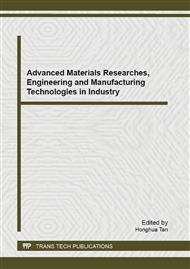p.241
p.245
p.250
p.256
p.262
p.269
p.274
p.281
p.286
Effects of Variations in Annealing Temperature and Annealing Time on the Spectral and Solid State Properties of Nickel Oxide (NiO) Thin Films
Abstract:
Chemical bath deposited nickel oxide (NiO) thin film samples were grown at room temperature of 30 °C on glass substrates. Samples k1, k2, and k3 were annealed for one hour at temperatures of 100 °C, 200 °C and 300 °C respectively, while as grown sample k4 served as a reference. A second set of samples k5, k7, and k8 were annealed at a constant temperature of 300 °C for time durations of 1H, 2H and 3H respectively, with as grown sample k6 as a reference. The spectral absorbance, transmittance and reflectance of all the thermally treated thin film samples were measured with a spectrophotmeter (D model Avantes Spec 2048 version 7.0) in the UV-VIS-NIR region of 300-900 nm wavelength. The results show distinctive variations in all the spectral properties for different combinations of annealing time and temperature, each starting at a threshold wavelength of 300 nm and ending with a distinctive minimum or maximum value. Deduced graphical values of the refractive index also show distinctive variations. For annealing time of 3 hours at a temperature of 300 °C, the results produced symmetric reflectance and symmetric refractive index with maximum values of 8% and 0.293 occurring at 500 nm wavelength and photon energy of 2.5 eV respectively. Direct transition band gap energy obtained for all the samples lie between 3.68-3.84 eV. The results reported in this paper clearly indicate that optimum combinations of production parameters of nickel oxide thin films can yield specific values of the properties for specific applications.
Info:
Periodical:
Pages:
262-268
Citation:
Online since:
September 2013
Authors:
Price:
Сopyright:
© 2013 Trans Tech Publications Ltd. All Rights Reserved
Share:
Citation:


